
All business continuity plans have to be proven to ensure business continuity at all times, regardless of the events that may occur that will require them. The recent extreme weather events in the Eastern United States has shown that traditional disaster recovery planning falls far short of achieving business continuity or even planned business recovery. Traditional disaster recovery planning is costly for most businesses. While these plans take into account the hardware, software, network and resources required to maintain continuity or achieve recovery, many fail to account for conditions that may occur that will cause many continuity or recovery plans to fail. Successful disaster recovery testing may provide a false sense of security, as it is usually conducted under normal conditions that will not detect situations that may exist during the course of a disastrous event.
Just some of the conditions, that were brought about by Hurricane Sandy and which exposed business continuity flaws were:
Power – Many generators were inoperable due to flooding. In addition, many of the generators that were operable ran out of fuel due to a widespread shortage or difficulty in deliveries.
Communications – While many companies spend a great deal of effort to ensure network diversification, many communication providers share infrastructure and route through common central operation centers. Many of these operation centers went dark during the storm causing massive communications outages across multiple vendors.
Travel & Availability – For disaster recovery plans that require re-location to another facility, airports were damaged and closed (some for days) and travel by road was difficult to impossible. Resource availability was severely impacted, due to power and cellular disruption that made communications with business partners and employees extremely difficult.
Since many experts are predicting that extreme weather events will be an on-going trend, disaster recovery planning needs to be replaced with an on-going business continuity model that can be verified on an on-going basis and executed on demand. The business continuity model needs to ensure the on-going execution of all applications at a redundant location, which can maintain up to the second information. Communications should be multi-modal, such as the use of Satellite, as well as vendor diverse to ensure on-going connectivity. Generators should be protected and based on a self-replenishing fuel source, such as natural gas. Most importantly, the mechanism to invoke the use of the continuity model needs to be seamless and with minimal disruption to ensure smooth on-going business operations.
Partnering with an expert provider of Business Continuity Services can enable you to establish a cost effective and reliable continuity model that will ensure your business continues to operate during a disaster.
For further information about establishing a continuity model, contact Superior Technology Solutions. We look forward to sharing our extensive technology background with your organization. For more information, visit us on the web at www.superiortechnology.com or call us at 845-735-3555.
Comments are closed.
